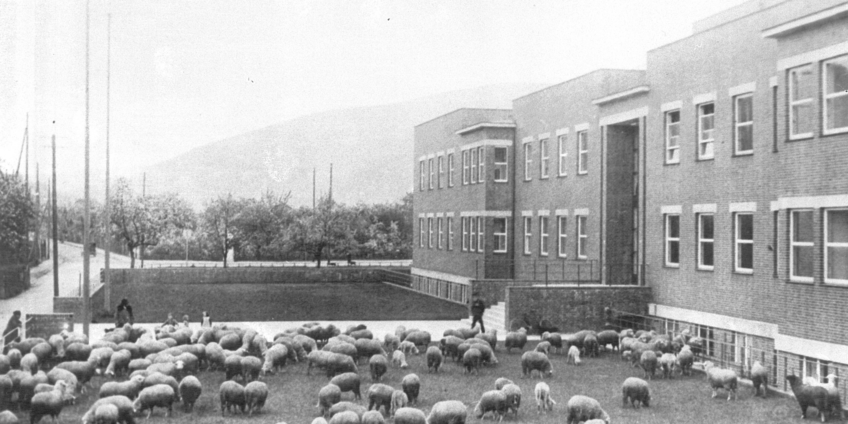
History of the institute
The Max Planck Society, to which the institute belongs, is the successor of the Kaiser Wilhelm Society, founded in Berlin in 1911. The goal of the KWS was to strengthen scientific research in Germany, particularly with regard to possible benefits for technological development, through organizations independent of the universities. Initially, the geographic centre of the KWS was in Berlin and Prussia.
In the 1920s, Ludolf von Krehl, a prominent Heidelberg physician, conceived the idea of a research institute for fundamental research on the border between clinical medicine and physics and chemistry. He had connections to influential people, in particular Adolf von Harnack, the first president of the KWS. The institute was opened in 1930, and the building was, for the period, an advanced construction, located on a site on the Neckar river donated by the town of Heidelberg. It was the first institute in what later became the modern science campus, and was the first KWI in southern Germany. The new institute housed departments of Physics, Chemistry, Physiology and Pathology, headed by Karl-Wilhelm Hausser, Richard Kuhn, Otto Meyerhof, and Krehl himself. Kuhn and Meyerhof did some of their most important work in the institute’s first years. Hausser, a physicist, formed a seminal collaboration with Kuhn, but he died in 1933 and was succeeded by Walther Bothe. Krehl died in 1937, before his department was fully equipped.
The National Socialists came to power in 1933, and the prospects for the institute began to decline. Meyerhof, who was Jewish, fled in 1938 to Paris and, when France was occupied by Germany in 1941, to Philadelphia -- under dramatic circumstances. A plaque in the institute recalls his fate and that of 22 other members of the institute staff who were forced to leave as a result of the Nazi legislation.
At the end of the war, the research was halted at the order of the victorious powers. The building had suffered little apart from a few broken windows, and very soon (in June 1945) Richard Kuhn received permission to continue his research. Historical investigations, facilitated by the opening of the archives in the 1990s, have revealed evidence of serious moral failings on Kuhn’s part in his research during the Nazi period (see literature list).
The Allies used the southern wings of the institute as an Aero-Medical Center, and the Physics department remained closed, except that the cyclotron remained in use. Walther Bothe returned to his former position at Heidelberg University. In 1948-1949, the KWS was re-founded under the name and honorary presidency of Max Planck. Bothe was not able to resume work at the institute until 1952. When he died in 1957, Wolfgang Gentner was appointed as his successor. The space available in the institute no longer met the demands of research in high-energy physics, and Gentner accepted the offer only on condition that the physics department became a new and separate institute. The new MPI for Nuclear Physics on the Königstuhl in Heidelberg was opened in 1962.
At the MPI for Medical Research, the tradition established by Kuhn’s chemical research was continued (T. Wieland, H. Staab). A further collaboration between physics and chemistry was in the development of NMR by K.H. Hausser, the son of K.W. Hausser; and the research on muscle physiology and biophysics started by Meyerhof was continued by H.H. Weber, W. Hasselbach, and K.C. Holmes. Developments in biology in the 1960s led to the founding of the department of Molecular Biology (H. Hoffmann-Berling). Towards the end of the 1980s and during the 1990s, neurophysiology became a new focus, and departments were established in Cell Physiology (Bert Sakmann, 1989-2007), Molecular Cell Research (Wolf Almers, 1992-1999), Molecular Neurobiology (Peter H. Seeburg, 1995-2016) and Biomedical Optics (Winfried Denk, 1999-2016). The department of llme Schlichting (2002- ) focusses on the mechanisms of complex enzymatic processes and folding operations in the cell. Just as in the development of synchrotron radiation by Holmes in the 1970s, the aim here is to exploit the availability of ever more intense X-ray sources for structural biology.
Collaboration between this department and the new departments of Stefan Hell, Joachim Spatz and Kai Johnsson (see Profile) will form the basis of a new institute-wide project in the coming years.
Since its foundation, five Nobel laureates have worked at the institute: Otto Meyerhof (Physiology or Medicine), Richard Kuhn (Chemistry), Walther Bothe (Physics), Bert Sakmann (Physiology or Medicine) and Stefan Hell (Chemistry).
The work for which Rudolf Mößbauer shared the 1961 Nobel Prize for Physics was performed here.
Literature (in German):
P. Gruss and R. Rürup (Eds.), Denkorte, Dresden: Sandstein Verlag 2010
F. Schmaltz, Kampfstoff-Forschung im Nationalsozialismus, Göttingen: Wallstein Verlag 2005
Directors of the KWImF / MPImF
(with periods of office)
Ludolf v. Krehl (1929-1937)
Otto Meyerhof (1929-1938) (Nobel Prize 1922)
Richard Kuhn (1929-1967) (Nobel Prize 1938)
Karl-Wilhelm Hausser (1929-1933)
Walther Bothe (1933-1957) (Nobel Prize 1954)
Hermann Rein (1952-1953)
Hans Hermann Weber (1954-1966)
Karl-Hermann Hausser (1966-1987)
Hartmut Hoffmann-Berling (1966-1987)
Wilhelm Hasselbach (1967-1988)
Theodor Wieland (1967-1981)
Kenneth C. Holmes (1973-2003)
Heinz Staab (1976-1996)
Bert Sakmann (1989-2007) (Nobel Prize 1991)
Wolf Almers (1992-1999)
Winfried Denk (1999-2016)
Peter H. Seeburg (1996-2016)
Ilme Schlichting (2002- )
Stefan Hell (2015- ) (Nobel Prize 2014)
Joachim Spatz (2016- )
Kai Johnsson (2016- )